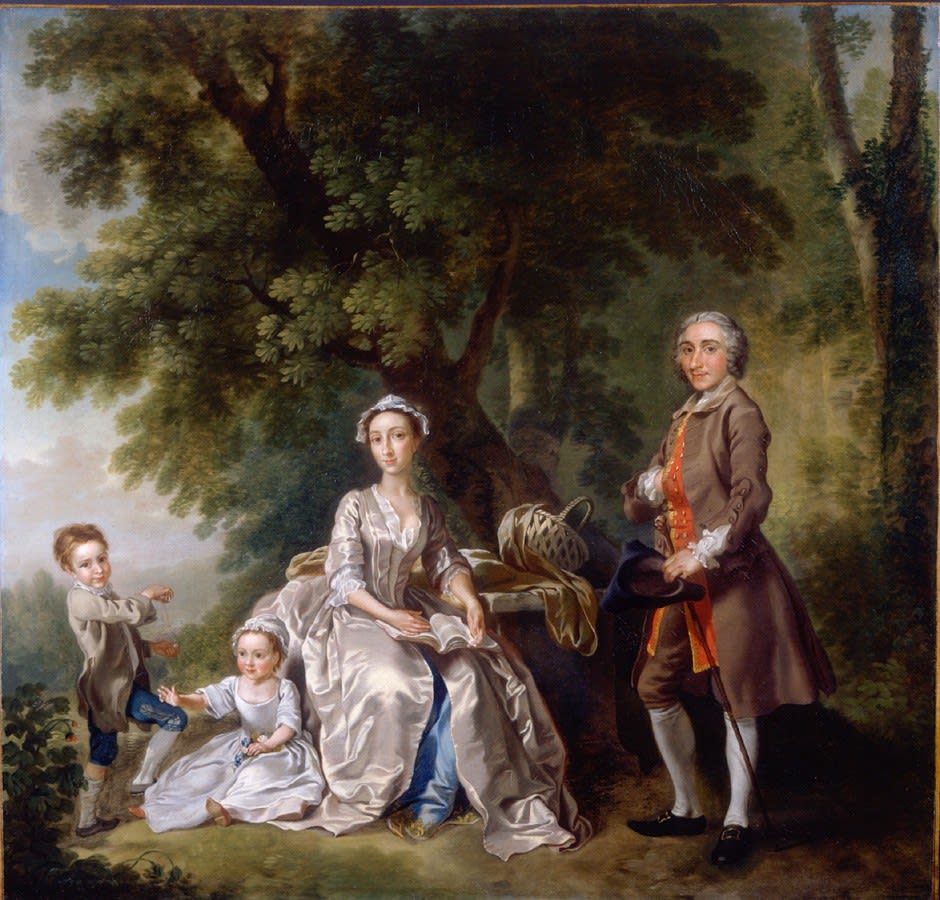
Francis Hayman
To view all current artworks for sale visit philipmould.com
This masterpiece of rococo portraiture shows that, free of the political and dynastic imperative of the aristocracy, the middle classes commissioned works that celebrated their easy and enjoyable life. Portraits such as these celebrated a town-dweller’s conception of harmless nature, human in scale and benign, that recalled the idyllic and artificial rus in urbe that Jonathan Tyers created for Londoners in the pleasure gardens at Vauxhall. It is no accident that Hayman was a friend of Tyers and was commissioned to paint large decorative paintings for the private supper boxes at Vauxhall as well as portraits of Tyers and his family. The Grant Family is directly comparable to Hayman’s Jonathan Tyers, his daughter Elizabeth and her husband John Wood (Yale Centre for British Art), traditionally dated to c.1750, but very probably painted earlier1, in placing the sitters before a wooded grove, with a landscape extending in an open view to the left. In each case, the figures are grouped about a stone plinth, which in the Tyers portrait supports a putto riding a dolphin and holding a dove. In The Grant Family this is replaced by Mrs Grant’s basket and shawl, a workaday substitution, but redolent of happy domesticity.
Like The Tyers Family, in which the reclining figure of Tyers may be a near quotation from Watteau, The Grant Family contains allusions to high art, and here they are almost slyly subversive. The figure of Grant’s elder son Richard is based in reverse on the pose of Lord Bernard Stuart in Van Dyck’s Portrait of Lord John and Lord Bernard Stuart (London, National Gallery). The colours of his costume, particularly the blue silk of his breeches, also mimic Lord Bernard’s costume, and the embroidered stripe to the seam make the reference explicit. His younger brother is stretching out his hand after a bright blue butterfly that can be seen against the flowering bush in the left foreground. This humorous and touching observation of childhood behaviour can also support a graver meaning. The butterfly that emerges from the chrysalis can be read as an allusion to the adulthood that the child has yet to enjoy, and in its fleeting life may be taken as a memento mori. The beauty and fragility of the butterfly only add to the intensity of the image, since in art and literature it has long been used as an emblem for the human soul.
1. Brian Allen Francis Hayman, New Haven and London, 1987, p. 101.
Provenance
The sitter;His son the Rev Richard Grant;
By descent to his granddaughter Marian Grant (d. 1872) who married Dr Frederick Dixon of Worthing;
By descent to her niece by marriage Mrs Caroline Webster Wedderburn (daughter of Captain William Dixon);
Her sale Christie's London, February 29th 1896, lot 84, as by Hogarth (bought by Colnaghi for 49 gns);
With Colnaghi;
Christie's London, July 14th 1911, lot 40, as by Highmore, bought by F. Harper 36 gns;
With F. Harper;
With Basil Tooth and sons, London (label verso);
Mr and Mrs Basil Ionides;
By descent to Lady Panufnik to 2004
Exhibitions
London, Iveagh Bequest, Kenwood, Francis Hayman, 1960, no. 12, lent by The Hon Mrs Ionides;London Arts Council, British Life, May 10th-July 11th 1953, no. 39;
London, The Victoria and Albert Museum, Rococo, Art and Design in Hogarth’s England, May 1
Literature
C. Gould, Country Life, Annual, 1949, p. 49, illustrated;Brian Allen, Francis Hayman, New Haven and London, 1987, p. 172, no. 21